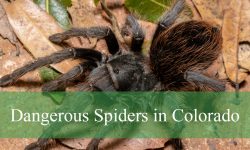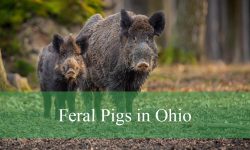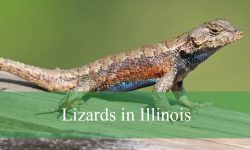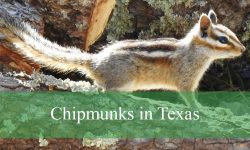Bees play a vital role in Arizona’s ecosystems, helping to pollinate a wide variety of native plants, wildflowers, and crops. The types of bees in Arizona are diverse, ranging from tiny solitary bees to larger social species, each specially adapted to the state’s deserts, grasslands, and mountainous regions. Learning about these different bees highlights their importance in supporting biodiversity and the health of natural habitats.
Arizona’s unique environment is home to many fascinating bee species. The types of bees in Arizona include well-known pollinators like honeybees and bumblebees, as well as many solitary bees such as leafcutters, sweat bees, and carpenter bees. Each species has distinct features, behaviors, and nesting habits that make Arizona a rich hotspot for bee diversity.
This article introduces 30 different types of bees in Arizona, featuring clear pictures and identification tips. By exploring their characteristics and ecological roles, you will gain a better understanding of the valuable contributions these bees make to Arizona’s vibrant natural world.
Different Types of Bees in Arizona
Valley Carpenter Bee

Valley Carpenter Bees (Xylocopa sponsoring) are commonly found in Arizona and surrounding states, easily identifiable by their entirely black, glossy bodies. Their black heads, wings, and hairy legs make them stand out among other native bees.
These bees are very efficient pollinators, largely due to their hairy legs which trap pollen as they visit flowers. Studies show they can visit up to 16 flowers per minute, including many from the Solanaceae family, which is significant for pollination in agricultural and natural habitats.
Valley Carpenter Bees are generally non-aggressive and rarely sting. Males lack stingers altogether, making them harmless to humans. Their pollination activities are essential for maintaining the health of Arizona’s plant biodiversity.
Hunt’s Bumble Bee

Hunt’s Bumble Bee (Bombus hunt) is an important pollinator, particularly valued in agriculture for its effectiveness in pollinating tomato plants. These bees are also frequent visitors to rabbitbrush and thistle flowers, which are common in the arid landscapes of Arizona.
This species is well adapted to a range of habitats, from dry lowlands in Arizona to higher volcanic mountain regions in Mexico. Their coloration includes classic black and yellow patterns, accented with distinctive orange-red markings on their backs.
Hunt’s Bumble Bees are known for their resilience and flexibility in harsh environments, contributing to the pollination of both wild and cultivated plants. Their presence in Arizona supports both natural ecosystems and agricultural productivity.
Ligated Furrow Bee
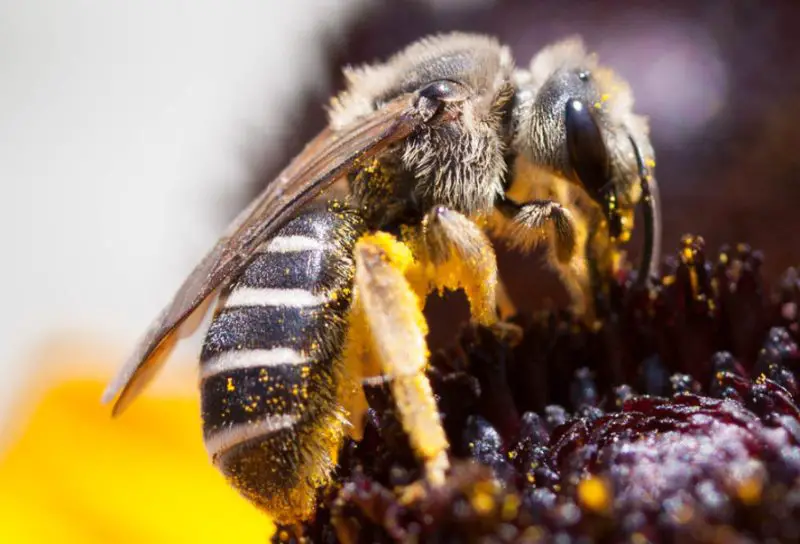
Ligated Furrow Bees (Halictus ligatus) play an important role in pollinating a wide range of flowering plants across Arizona. These bees are efficient foragers that often select flowers offering high-protein pollen, although they tend to visit different floral species throughout the day. Their pollination efforts are vital for maintaining Arizona’s native plant diversity.
This species is eusocial, living in colonies with well-structured social roles. They build their nests underground in well-drained soil, often forming large aggregations. The queen leads the colony, but the species is known for high aggression levels, especially among females, leading to frequent conflicts within the colony.
Behaviorally, Ligated Furrow Bees display intense territoriality and competition, which is uncommon in many other native bees. This aggressive nature likely influences colony dynamics and helps secure resources in Arizona’s competitive desert and semi-arid environments.
California Digger Bee
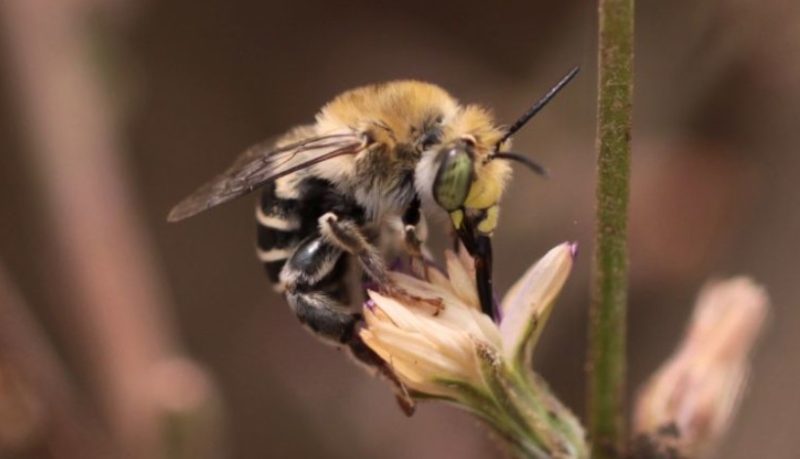
The California Digger Bee (Anthophora californica) is a large, visually striking bee native to the southwestern United States, including Arizona. They have a distinctive golden, hairy thorax paired with a shiny abdomen marked by contrasting black and white bands, making them relatively easy to identify.
Males exhibit unique adaptations on their legs resembling blades, which aid them in grasping females securely during mating. These bees nest underground, where males often wait near the nest entrances to encounter and mate with emerging females.
Active mostly in the fall, California Digger Bees forage on native flowers such as pigeonberry and Silver-leaf nightshade. Both sexes feed on nectar, contributing to pollination of these plants during Arizona’s late flowering season.
Honey-tailed Striped Sweat Bee
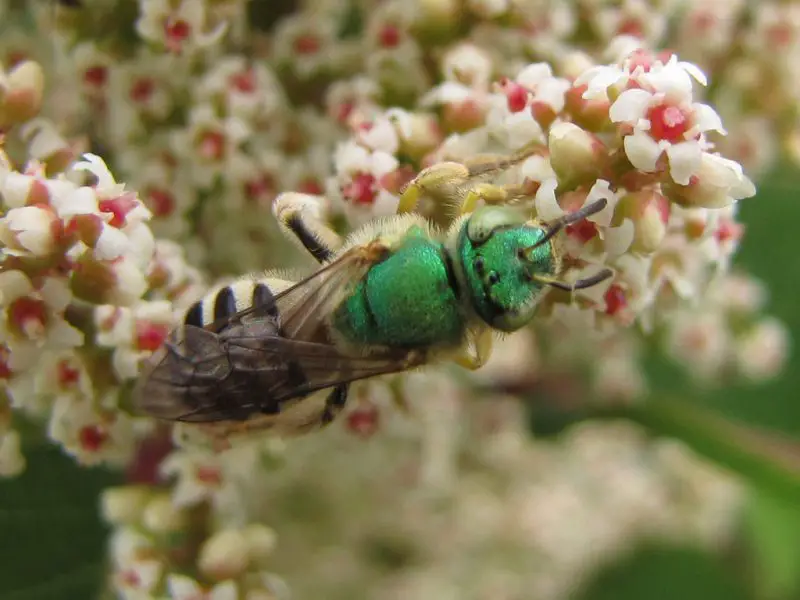
The Honey-tailed Striped Sweat Bee (Agapostemon melliventris) is a colorful and important pollinator found in Arizona’s gardens and urban parks. Both males and females share a metallic green thorax, but their abdomens differ: females have alternating golden and black bands, while males show yellow and black striping.
These bees have a one-year lifespan, typically living through a single active season. They are social creatures and are often observed foraging or resting in groups, making them easily noticeable in flowering areas.
As a member of the sweat bee family, they are attracted to human perspiration, which provides moisture and salts, but they are not aggressive and rarely sting. Their presence benefits many ornamental plants in Arizona’s cultivated green spaces.
Tripartite Sweat Bee

Tripartite Sweat Bees (Halictus tripartitus) belong to the Halictidae family and are common pollinators within Arizona’s ecosystems. They can be identified by their brown heads and antennae, with a thorax of similar brown shade and a lighter brown abdomen marked with yellow bands.
Their wings are transparent brown, and short yellow hairs cover much of their body and legs, aiding in pollen collection. These physical traits help distinguish them from other sweat bee species in the region.
They tend to nest in the ground and live solitary or semi-social lives. Their moderate size and subtle coloration allow them to blend well into dryland habitats and open woodlands throughout Arizona.
Cellophane Bees
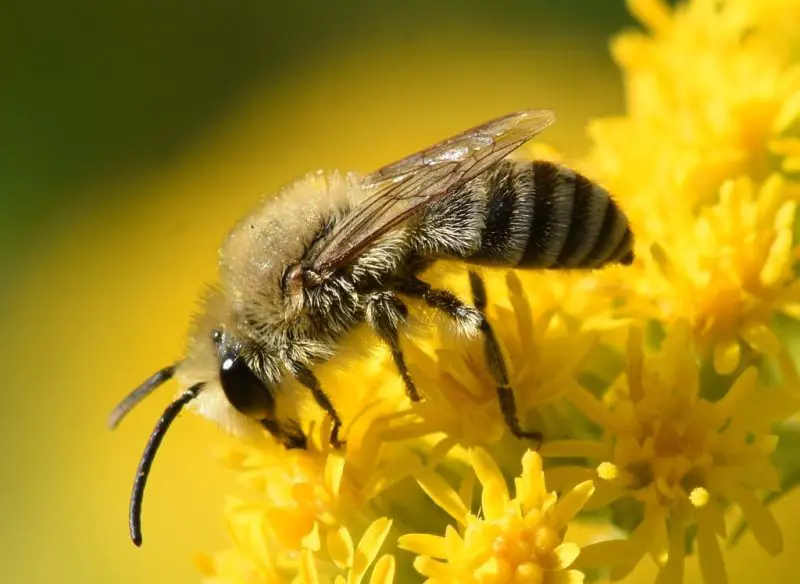
Cellophane Bees (Genus Colletes) vary in size from 7mm to 16mm and are notable for their distinctive black and white banded abdomens. Their clear wings and pointed gasters give them a sleek appearance, while their heads often show a combination of white and black markings.
These bees are ground nesters, creating shallow burrows only a few inches deep. Because their nests are close to the surface, Cellophane Bees can often be seen near their nest entrances in Arizona’s dry, sandy soils.
Known for their unique ability to produce a cellophane-like lining inside their nests, this waterproof and protective material safeguards their developing larvae from moisture and pathogens, an adaptation well-suited to Arizona’s often arid environment.
California Digger-cuckoo Bee
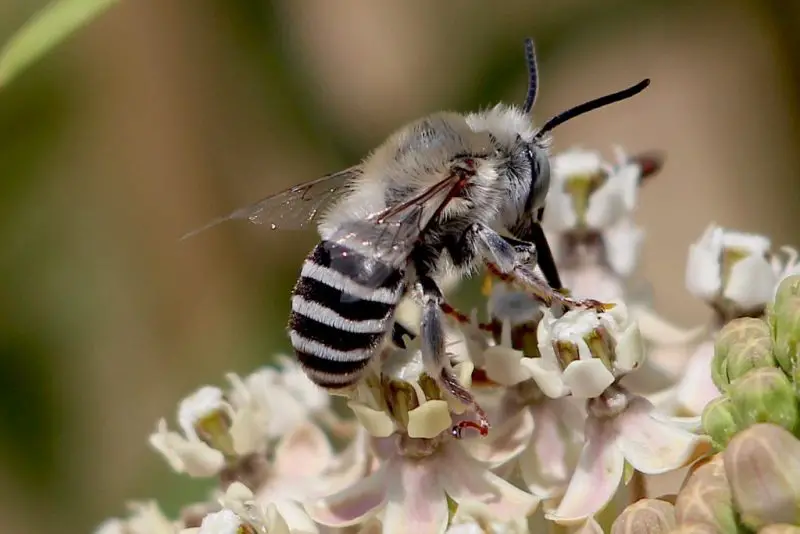
California Digger-cuckoo Bees (Brachymelecta californica) have a distinctive appearance with pointed black and white abdomens similar to Cellophane Bees, but they are uniquely marked with pale yellow hairs scattered on the abdomen. This feature helps distinguish them from other species with similar coloration.
These bees are widespread across Arizona and other parts of the United States, making them one of the more common members of the Brachymelecta genus. Historically, they were considered extremely rare, but recent observations have shown their broader presence throughout the state.
Unlike many other bees, California Digger-cuckoo Bees are cleptoparasitic, meaning they lay their eggs in the nests of other bees, particularly ground-nesting species. This behavior reduces their need to build nests or gather pollen themselves, relying instead on host species for reproduction.
Barrel Cactus Longhorn

The Barrel Cactus Longhorn Bee (Svastra duplocincta) is a well-known pollinator native to Arizona, Texas, and Northern Mexico. It is commonly observed in urban centers such as Phoenix, Tucson, and Flagstaff, where the species thrives in desert environments.
These bees can be identified by their striking golden and black coloration. Their thorax is covered in dense golden hairs, while the abdomen features a distinctive golden-black pattern, giving them a furry and robust appearance.
Specialized in pollinating the flowers of Compact Barrel Cactus, these bees play a vital role in the reproduction of desert plants. Their hairy bodies allow efficient pollen transfer, making them essential for maintaining the health of native cactus populations.
Western Honey Bee
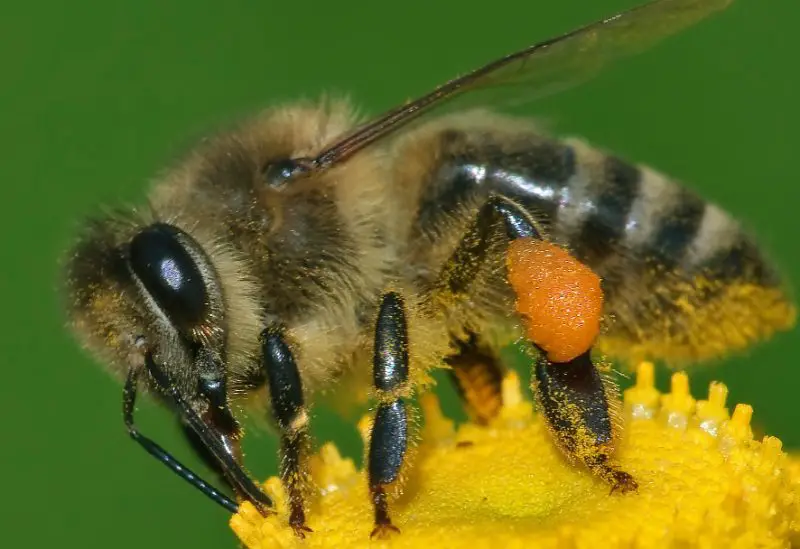
The Western Honey Bee (Apis mellifera) is the most widespread and familiar bee species found throughout Arizona. Originating from Europe and introduced globally by the 17th century, this species now thrives across many environments. In Arizona, they are especially common due to their adaptability and essential role in pollination.
Western Honey Bees have several subspecies, identifiable by their distinctive coloration patterns, including orange-yellow bands interspersed with black stripes and a densely hairy thorax. Queens are the largest individuals, measuring about 20mm in length, while drones are slightly smaller at 17mm, and worker bees typically reach up to 15mm.
These bees prefer habitats where water sources and flowering plants are abundant, such as wetlands and drylands. They nest inside cavities and play a crucial role in pollinating a wide variety of plants in Arizona. Their honey, a product of pollen collected from diverse floral sources, mainly contains fructose and glucose, prized for its taste and nutritional qualities.
Western Carpenter Bee
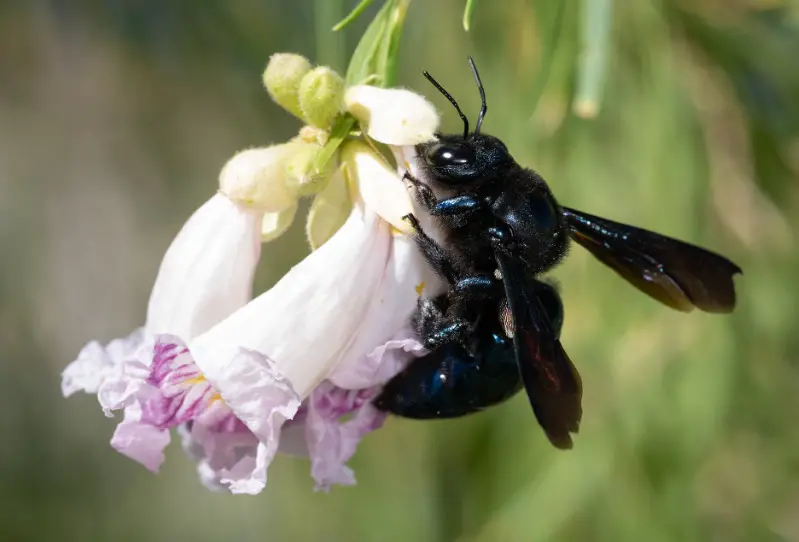
The Western Carpenter Bee (Xylocopa californica), also called the California Carpenter Bee, is native to the southwestern United States, including Arizona. This species is easily recognized by its shiny black body and robust size, often spotted in forests and meadows throughout the state.
Females of this species have a completely dark, glossy appearance, whereas males are somewhat lighter, featuring sparse pale hairs. Both sexes have solid black wings and antennae. These bees are most active during late summer when they can frequently be seen foraging.
Known for their wood-boring behavior, Western Carpenter Bees excavate tunnels in dead wood or soft timber, which they use for nesting. Despite this, they play an important ecological role by pollinating desert flowers and woodland plants, supporting Arizona’s diverse ecosystems.
Sonoran Bumble Bee
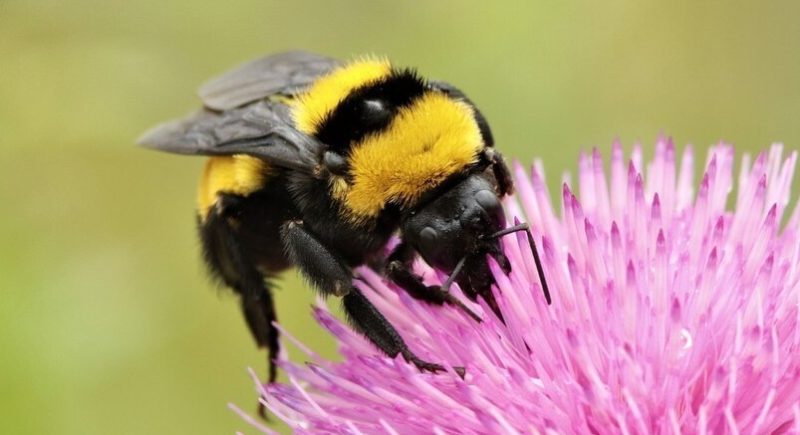
The Sonoran Bumble Bee (Bombus sonorus) is a native pollinator of the Sonoran Desert region. It is distinguished by its striking black and yellow coloration and relatively large size, growing up to 18mm in length. These bumble bees are adapted to the desert climate and have unique behavioral patterns.
Unlike many bumblebee species that are most active during spring and early summer, Sonoran Bumble Bees primarily fly in late summer and fall. This seasonal activity helps them exploit floral resources that bloom later in the year in Arizona’s desert environment.
They nest underground or in hidden cavities, with colonies lasting up to one year. Unlike honey bees, their colonies have less rigid caste roles, with most individuals involved in pollen collection and nest maintenance. Their contribution is vital for the pollination of many desert plants.
Morrison’s Bumble Bee

Morrison’s Bumble Bee (Bombus morrisoni) remains a notable species in Arizona despite its declining numbers in other western states like California. It is recognized by its nearly entirely yellow-golden body, contrasted sharply by a black last abdominal segment and black legs.
This species exhibits flexible nesting habits, making its home either underground in natural cavities or above ground in sheltered locations. This adaptability helps Morrison’s Bumble Bee survive in the varying terrains and climates found across Arizona.
Morrison’s Bumble Bees contribute significantly to pollinating plants such as thistle, rabbitbrush, and milkweed. Their presence supports these native flowers and aids in sustaining Arizona’s diverse desert ecosystems.
Peridot Sweat Bee
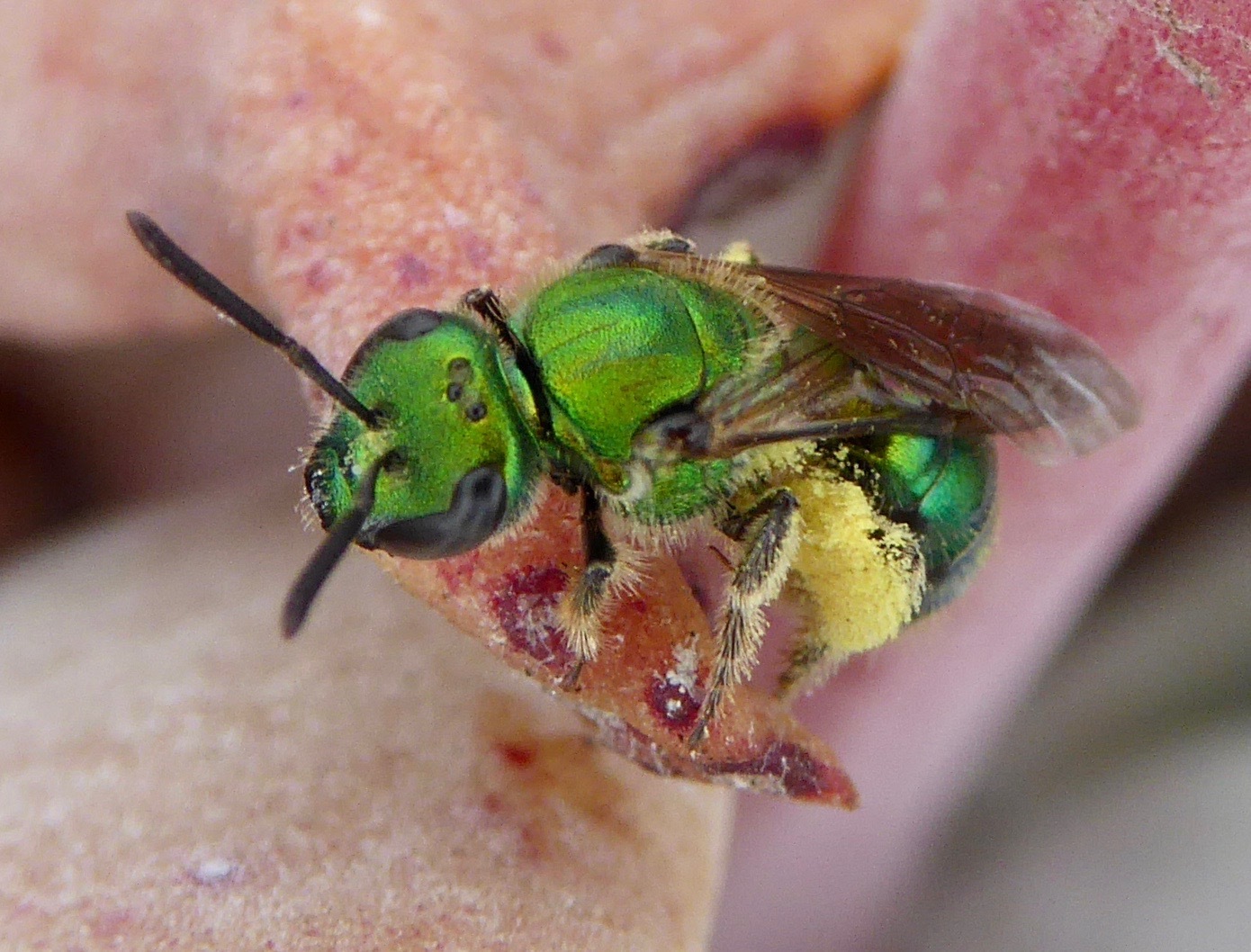
Peridot Sweat Bees (Augochlorella pomoniella) stand out with their brilliant metallic green coloration, often highlighted by golden reflections that make them easy to spot. These bees are relatively small, averaging around 10mm, with males sometimes as tiny as 7mm.
They prefer nesting in well-drained soils across woodlands and dry areas of Arizona. Instead of creating new burrows, these bees often expand existing cavities underground, constructing multiple chambers within their nests for laying eggs and rearing larvae.
As efficient pollinators, Peridot Sweat Bees visit a variety of flowers, including wild roses, alfalfa, and goldenrod. Their activity benefits both wild plants and cultivated gardens, supporting Arizona’s floral biodiversity.
Black-tailed Bumble Bee

The Black-tailed Bumble Bee (Bombus melanopygus) is named for its characteristic black abdomen, which contrasts vividly with its golden yellow-brown thorax. This hairy bee is widely recognized for its strong pollination skills and adaptability.
Found throughout multiple Arizona habitats, including urban areas, these bumble bees prefer nesting underground but are also capable of nesting in above-ground shelters when suitable sites are available.
Black-tailed Bumble Bees pollinate a variety of plants such as willows, lilacs, and wild buckwheat. Their presence in diverse environments makes them crucial contributors to the health of both natural and cultivated plant communities in Arizona.
Nevada Bumble Bee
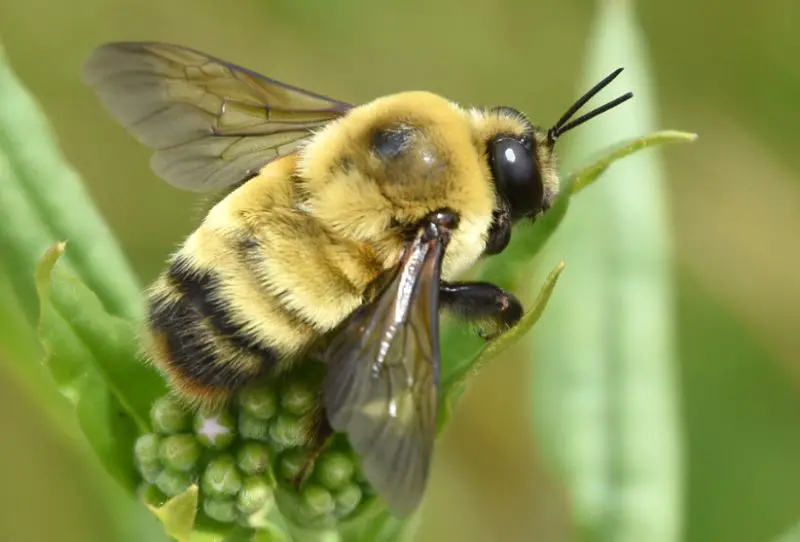
The Nevada Bumble Bee (Bombus nevadensis) is a widespread species across the United States, including the diverse landscapes of Arizona. Despite its name, it is not limited to Nevada but thrives in various regions. These bumble bees are easily recognized by their thick coats of yellow and black fur, which play a crucial role in collecting and transferring pollen during foraging.
Sexual dimorphism is apparent in this species beyond just their size difference: females possess entirely black heads, while males have black heads adorned with distinct yellow markings. Female Nevada Bumble Bees typically reach up to 17 millimeters in length, whereas males are slightly smaller, growing up to 14 millimeters.
In Arizona, these bees predominantly inhabit open prairie environments, where they forage on native flowering plants like thistles and penstemons. Their preference for such plants highlights their important role in pollinating prairie ecosystems. The Nevada Bumble Bee’s ability to thrive in these open habitats contributes significantly to the health of local wildflowers and natural plant communities.
Urbane Digger Bee
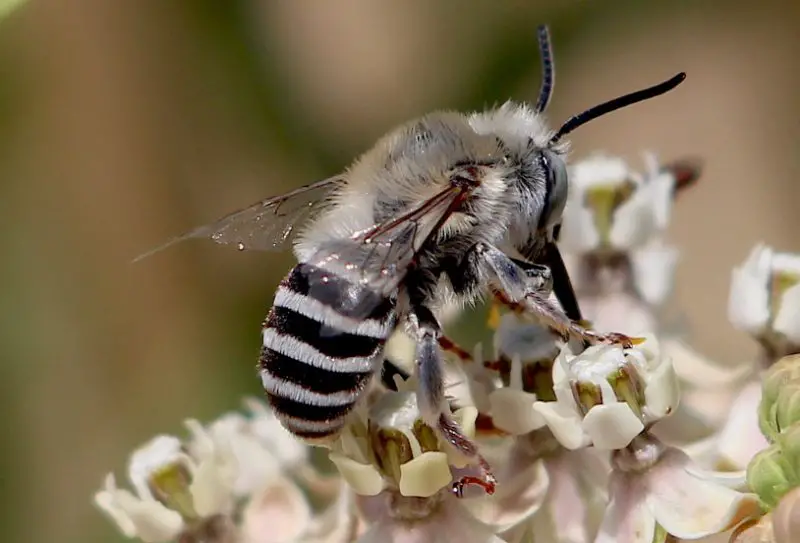
The Urbane Digger Bee (Anthophora urbana) is a distinctive species noted for its furry appearance, marked by a combination of yellow and black coloration across its body. Its legs are black but feature yellow hairs, complementing the black wings and antennae that complete its unique look.
This species exhibits solitary nesting behavior, creating individual burrows in the ground. These nests are typically clustered together, with each tunnel just a few inches deep beneath the surface. In Arizona’s environment, these underground nests provide a safe and stable habitat for raising their young.
Male Urbane Digger Bees emerge later in the season and spend their time near these nests, waiting to mate with females. This mating behavior occurs close to the nesting sites, ensuring that reproductive activities happen in proximity to safe environments for offspring development. The species’ lifecycle and behavior are finely adapted to the local climate and soil conditions in Arizona.
Red-legged Centris

The Red-legged Centris (Centris rhodopus) is a rare but fascinating bee species that inhabits Arizona as well as regions of Central America. It stands out due to its vibrant yellow thorax contrasted with a black abdomen, creating a striking appearance that is hard to miss.
One of the most notable features of this species is its red legs, which give the bee its common name. Additionally, the Red-legged Centris has large red eyes, a characteristic that further distinguishes it from other bees in the region.
In Arizona, this bee is typically found in habitats where flowering plants provide ample nectar and pollen. While it is not commonly seen due to its rarity, its presence highlights the diversity of bee species in the desert and semi-arid environments of the state. Its adaptations allow it to survive and pollinate within these challenging ecosystems.
Pallid Desert-Digger

Known commonly as the Desert Bee, the Pallid Desert-Digger (Centris pallida) is prevalent in both Arizona and Nevada, thriving in the arid desert landscapes. Unlike many bees that favor forested or meadow environments, these bees specialize in pollinating desert flora, including cacti and desert willow, playing a critical ecological role in desert ecosystems.
Pallid Desert-Digger bees are remarkable for their sophisticated communication system based on pheromones. Virgin females emit specific chemical signals before emerging from their underground nests, which attract other females to the area. This pheromone signaling also explains the presence of males who patrol near these nests, searching for mates.
These bees dig nests underground, where they spend part of their life cycle protected from harsh desert conditions. Their ability to live and reproduce in such a demanding environment demonstrates their unique adaptation and specialization within the diverse bee population of Arizona.
Spotted Woolcarder
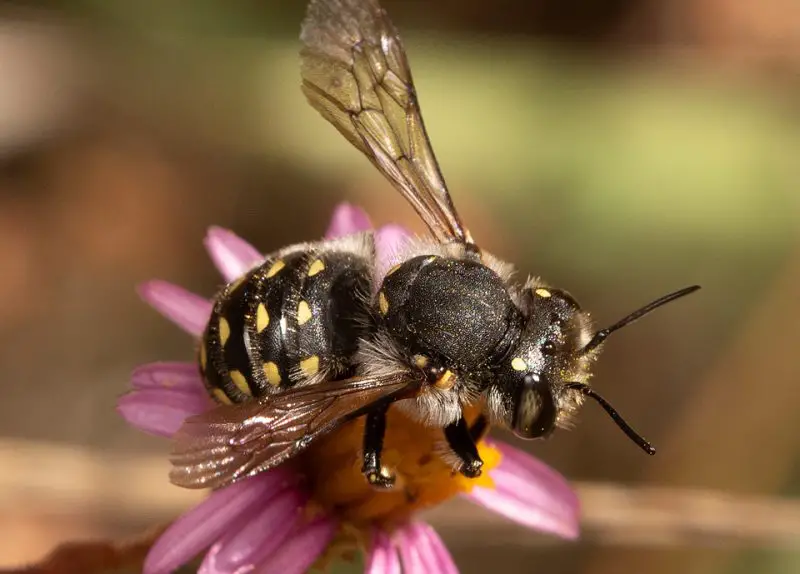
The Spotted Woolcarder (Anthidium maculosum) is a solitary bee recognized for its compact, robust body covered in black and yellow coloration. Male bees feature striking orange hairs on their heads, adding to their distinctive look. These bees are known for their unusual mating system called polyandry, where females mate with multiple males.
Unlike eusocial bees, Spotted Woolcarders do not live in colonies. However, males exhibit territorial behavior, fiercely defending areas that contain multiple females. This territoriality ensures they have the best chance of mating opportunities, which impacts their reproductive success.
In Arizona, Spotted Woolcarder bees can be found in habitats where flowers are abundant, supporting their solitary and independent lifestyle. The size of individuals influences their dominance and mating ability, with larger males typically having more success in defending territories and attracting females. This bee’s unique behaviors contribute to the ecological complexity of Arizona’s pollinator communities.
Oblique Longhorn

The Oblique Longhorn bee (Svastra obliqua), often called the Sunflower bee, is a native species widely found across the United States, including Arizona. This bee is notably large compared to many others, with females reaching up to 19 millimeters and males up to 15 millimeters in length, making them easy to spot in their natural habitats. Their vibrant orange color further distinguishes them as some of the most eye-catching pollinators in the region.
As their nickname suggests, Oblique Longhorns play an important role in pollinating sunflowers, which are common in Arizona’s open fields and gardens. Beyond sunflowers, they also visit gaillardia flowers and asters, although they are generalist pollinators that help many flowering plants across various habitats. Their strong preference for sunflower pollen supports the reproduction of this iconic wildflower species in desert and prairie ecosystems.
In Arizona, these bees thrive in sunny, open areas where their preferred plants grow abundantly. Their large size and hairy bodies allow them to collect pollen efficiently, aiding in the pollination process crucial to the survival of many native plants. The Oblique Longhorn’s presence highlights the rich diversity of bee species supporting Arizona’s floral communities.
Parosela Long-horned Bee
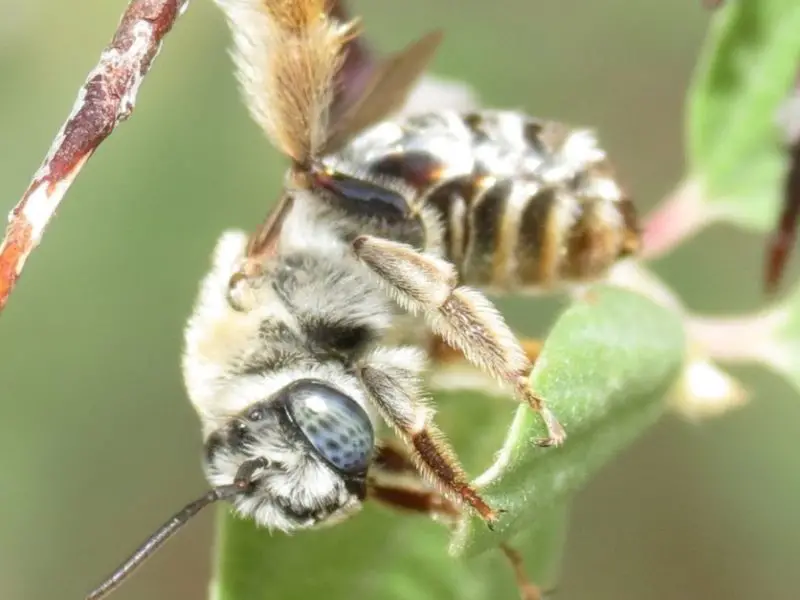
The Parosela Long-horned Bee (Melissodes paroselae) is a striking, multi-colored bee native to North and Central America and is well-established in Arizona. This smaller species averages around 9 millimeters, making it one of the more compact long-horned bees in the region. Its distinctive red markings make it stand out among native bees, adding to its identification ease.
This bee’s body displays alternating yellow or white and black bands, creating a bold pattern. The legs, antennae, and wings all bear a red tint, enhancing its vibrant appearance. Such coloration not only makes the Parosela Long-horned Bee visually unique but may also play a role in species recognition during mating or territorial behaviors.
In Arizona’s varied environments, the Parosela Long-horned Bee typically frequents areas rich in wildflowers, including its namesake plants from the parosela genus. Its smaller size and colorful markings enable it to exploit floral resources that larger bees might overlook, contributing to the pollination diversity of the state’s ecosystems.
Lasioglossum sisymbrii
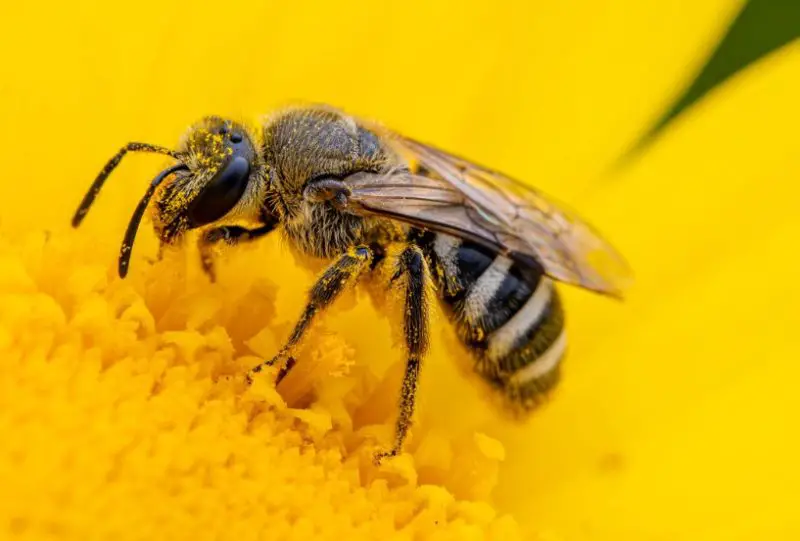
Lasioglossum sisymbrii is a native bee species known for its distinctive black and white banded, furry body. These bees possess transparent white wings, giving them a delicate and subtle appearance despite their important ecological role. Their range spans the western United States and into Mexico, though in Arizona they are less common compared to neighboring states like California and Nevada.
Belonging to the Halictidae family, Lasioglossum sisymbrii are eusocial bees that live in colonies, which is somewhat uncommon among many solitary bee species in the region. Their social structure allows them to work cooperatively in building nests and caring for offspring, contributing effectively to pollination as generalists.
In Arizona, these bees can be found in habitats that support their social nesting habits, often in sandy or loose soil where they build their colonies. While not abundant, they play a significant role in the pollination of various native and cultivated plants, supporting the biodiversity and health of local ecosystems.
Calliopsis subalpina
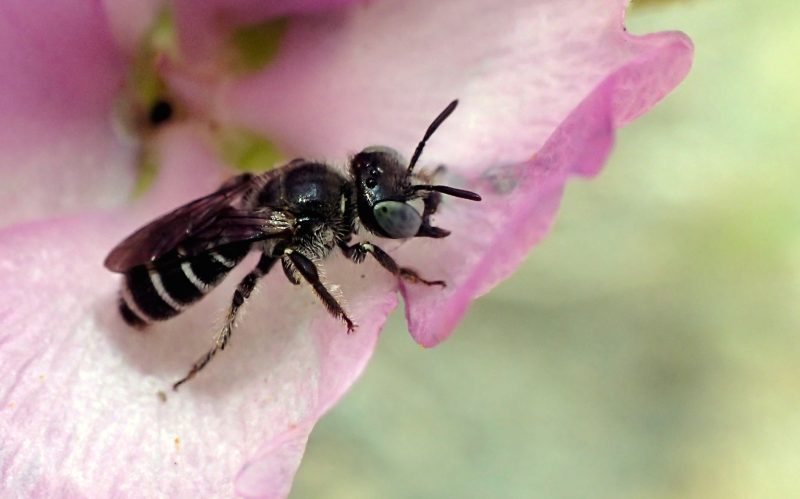
Calliopsis subalpina is a member of the Andrenidae family known for nesting in loose soil, a behavior well-suited to Arizona’s desert and semi-arid environments. This species stands out as one of the few all-black, shiny bees found in the state, with bright yellow markings specifically located at the tops of their antennae, providing a subtle but distinct identifying feature.
Unlike many bees active during the day, Calliopsis subalpina is nocturnal or vespertine, meaning it forages mainly in the evening. This unique behavior is supported by their enlarged ocelli—specialized simple eyes that improve vision in low light conditions. This adaptation allows them to exploit floral resources unavailable to daytime pollinators, reducing competition.
Their nighttime activity means they pollinate flowers that open or produce nectar during the evening, adding an important layer of pollination to Arizona’s desert ecology. Calliopsis subalpina’s niche lifestyle and physical adaptations demonstrate the wide variety of survival strategies employed by bees in the region.
Megachile perihirta
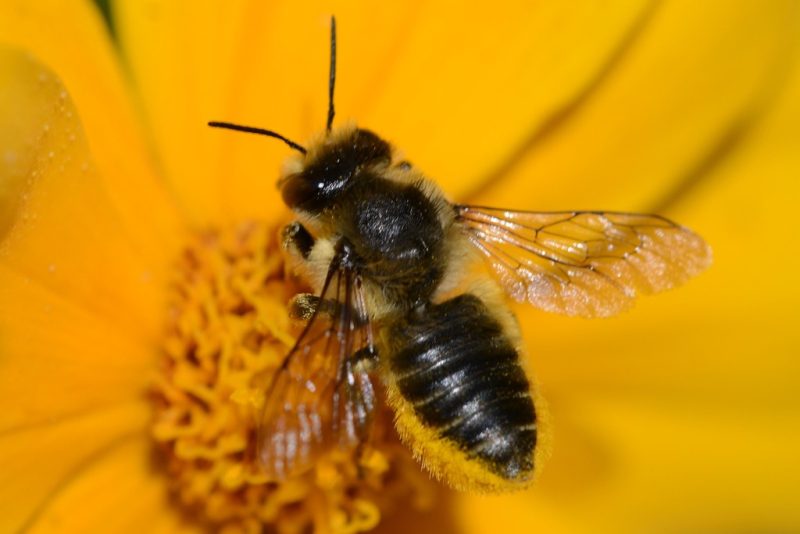
Megachile perihirta, commonly known as the Leafcutter Bee, is easily recognizable by its unique behavior of cutting neat, circular pieces from leaves to construct its nest. This species plays a vital role in pollinating many native wildflowers and crops found throughout the desert and grassland regions of Arizona. Their strong mandibles allow them to carefully harvest leaf fragments without harming the plant excessively.
These bees are solitary but efficient pollinators, often seen visiting a wide variety of flowering plants during the warmer months. They carry pollen on specialized hairs located on the underside of their abdomen, which helps them transfer pollen effectively between flowers. Their nests are usually built in hollow stems or pre-existing cavities, lined meticulously with leaf pieces to protect their larvae.
In Arizona’s harsh environment, Megachile perihirta thrives in areas with abundant flowering plants, especially in grasslands and desert fringes where they contribute significantly to local ecosystems. Their presence supports both wild plant reproduction and agricultural productivity, making them an important species for maintaining biodiversity in the region.
Augochlorella aurata

Augochlorella aurata, known as the Golden Sweat Bee, is a small, shimmering yellow bee that is widespread across Arizona and neighboring states. These tiny bees are most active during spring and early summer, when wildflowers are in full bloom. Their brilliant golden coloration makes them stand out among other pollinators in the desert landscapes.
These bees are ground-nesting and often create small colonies. They are known for their gentle behavior and their attraction to human sweat, which provides them with necessary moisture and salts. Augochlorella aurata plays a key role in pollinating numerous wildflower species, supporting the health of natural plant communities in Arizona.
Their adaptability allows them to inhabit various environments, from desert edges to gardens and meadows. Despite their small size, Golden Sweat Bees are efficient pollinators, contributing to the survival of many flowering plants that rely on insect pollination in the arid and semi-arid climates of Arizona.
Ceratina calcarata
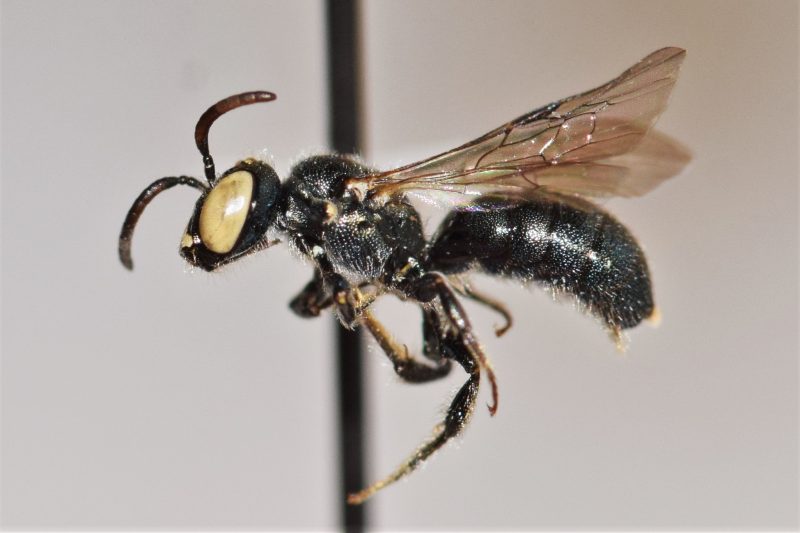
Ceratina calcarata, or the Small Carpenter Bee, is a diminutive bee species often mistaken for a tiny bumblebee. Unlike its larger carpenter bee relatives, this species prefers nesting inside small twigs or decayed plant stems, excavating shallow tunnels to raise its young. Their dark, often shiny bodies help them blend into their natural surroundings.
These bees are solitary but exhibit a remarkable level of care for their offspring. Ceratina calcarata is active throughout the growing season, pollinating a variety of wild plants and garden flowers. They carry pollen on their hind legs and are known to visit flowers for both nectar and pollen, aiding in cross-pollination.
In Arizona, Small Carpenter Bees are commonly found in shrublands and areas with abundant woody vegetation. They play a crucial ecological role by supporting the reproduction of native plants and maintaining healthy ecosystems, especially in regions where larger pollinators might be scarce.
Melissodes agilis
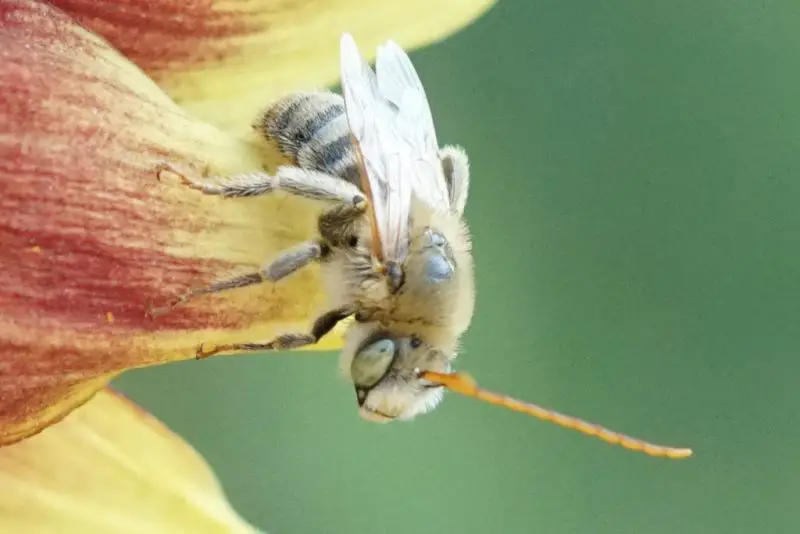
Melissodes agilis, often called the Agile Longhorned Bee, is recognized by its long antennae and rapid flight. This species is commonly spotted in Arizona’s grasslands and wildflower-rich habitats, where it visits a variety of flowers for nectar and pollen. Their elongated bodies and distinctive long antennae set them apart from other bees.
These bees are solitary ground nesters, excavating tunnels where they provision their young with pollen collected mainly from composite flowers like sunflowers. Melissodes agilis is especially active during late summer and fall, making it an important pollinator for late-blooming desert plants.
In the diverse floral environment of Arizona, Agile Longhorned Bees contribute significantly to the pollination of wildflowers, supporting the resilience of desert and grassland ecosystems. Their presence indicates healthy plant communities and balanced ecological interactions.
Diadasia rinconis
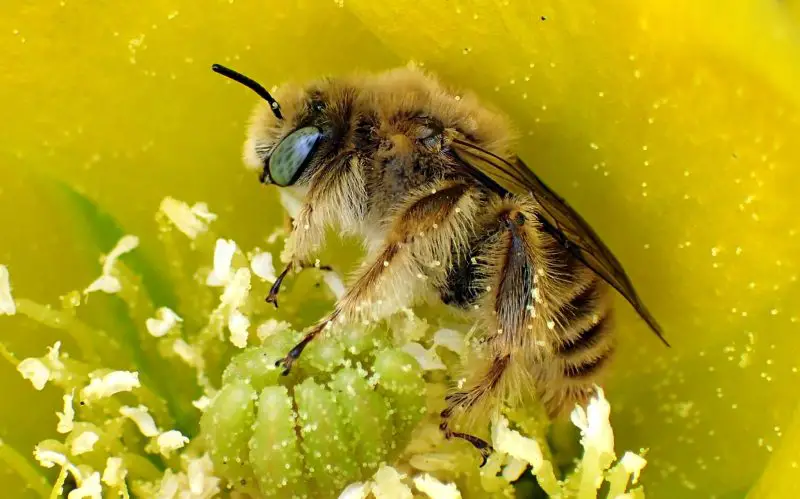
Diadasia rinconis, known as the Cactus Bee, is a specialist pollinator closely associated with native cactus species in Arizona. This bee species is easily identified by its sandy-colored body, which blends well with the desert surroundings. Its life cycle and behavior are tightly linked to the flowering period of cacti, making it an essential pollinator for these iconic desert plants.
Cactus Bees are solitary ground nesters that emerge in synchrony with cactus blooms, ensuring efficient pollen transfer between flowers. They collect pollen exclusively from cactus flowers, demonstrating a remarkable evolutionary relationship with their host plants. This specialization helps maintain the reproductive success of several cactus species native to Arizona.
These bees thrive in arid and semi-arid regions where cacti dominate the landscape. Their pollination services are crucial for the survival of desert ecosystems, supporting not only plant diversity but also the animals that depend on cacti for food and shelter.
Colletes thoracicus

Colletes thoracicus, commonly called the Polyester Bee, is notable for its unique ability to produce a polyester-like secretion that it uses to line and waterproof its underground nests. This fascinating adaptation protects their brood from moisture and pathogens in the variable climate of Arizona’s semi-desert regions.
These bees excavate their nests in loose soil, often in sunny areas with sparse vegetation. Their slender bodies and distinctive facial markings help with species identification. Polyester Bees are solitary but often nest in aggregations, making their nesting sites visible as clusters of small holes in the ground.
In Arizona, Colletes thoracicus inhabits semi-arid environments where it contributes to pollinating a wide range of wildflowers. Their specialized nesting technique and pollination role make them important players in maintaining the biodiversity and ecological stability of the region’s dry habitats.


